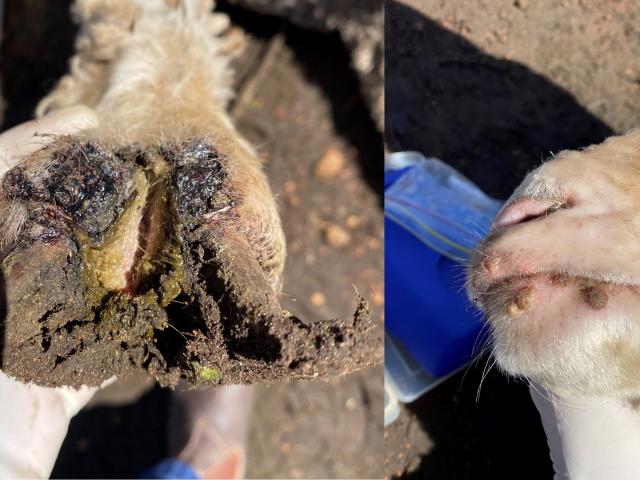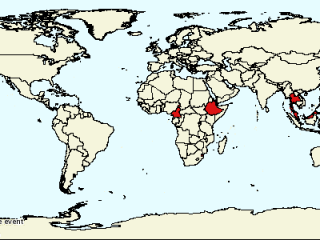Livestock disease investigations protect our marketsAustralia’s ability to sell livestock and livestock products depends on evidence from our surveillance systems that we are free of particular livestock diseases. The WA Livestock Disease Outlook summarises recent significant disease investigations by Department of Primary Industries and Regional Development (DPIRD) vets and private vets that contribute to that surveillance evidence. |
Recent livestock disease cases in WA
Footrot and foot-and-mouth disease ruled out in lame sheep
- A producer contacted DPIRD to report lameness in one mob of sheep on his property.
- The producer noticed seventeen of 170 Merino hoggets were lame when they were brought into the yards.
- It is important for lameness to be investigated as lameness can be a sign of important reportable diseases such as foot-and-mouth disease and virulent footrot. In this case, a DPIRD field vet and biosecurity officer attended the property and conducted an investigation. Samples were taken to exclude virulent footrot and foot-and-mouth disease.
- Clinical signs in the affected sheep included lameness, with severe excoriation and swelling of the distal limb, some with exudate in the interdigital space. Crusts had formed around lesions on the distal limb and firm, nodular, proliferative scabs were evident on the muzzle and lips of some sheep.
- The vet’s provisional diagnosis was contagious ecthyma (scabby mouth) with secondary infection.
- Laboratory tests were used to support the vet's diagnosis and to provide evidence of freedom from exotic and reportable diseases.
- The vet took swabs from the interdigital space of some affected sheep and placed them in footrot media for PCR testing and into Amies media for bacterial culture.
- The vet also collected serum and EDTA bloods from affected sheep and swabs in viral transport media (VTM) of the lesions on the limbs. The swabs and bloods were used to exclude the reportable diseases foot-and-mouth disease and vesicular stomatitis.
- DPIRD lab results were negative for both benign and virulent footrot. Testing at the Australian Centre for Disease Preparedness was negative for foot-and mouth-disease and vesicular stomatitis.
- Test results revealed interdigital dermatitis, with a mixed bacterial infection.
- The laboratory staff cultured the bacteria Bacteroides pyogenes, Fusobacterium necrophorum and Trueperella pyogenes.
- These agents are commonly implicated in secondary infections of ruminants and interdigital dermatitis, F. necrophorum in particular.
- Contagious ecthyma causes raised scabs and ulceration on the lips, muzzle and nostrils (most commonly) but can also cause lesions on the eyes, feet, lower leg, anus, vulva, udder, scrotum and pizzle (less commonly). Lesions can become infected and flystrike can occur, particularly when the feet are infected.
- Contagious ecthyma is a significant disease for live export and it is imperative that any sheep destined for live export is vaccinated and immune against scabby mouth prior to shipping.
- Trading partners may reject whole consignments of sheep with scabby mouth.
- Contagious ecthyma is a zoonotic disease. Infection usually occurs through needlestick injury while giving vaccinations, but can also occur through a break in the skin when handling affected animals. Vets should avoid contact with the scabs and cover cuts and abrasions before handling animals, as well as washing hands and clothes thoroughly after handling.
Horse with respiratory signs and pyrexia tests negative for Hendra virus
- A private vet contacted the Emergency Animal Disease Hotline to report pyrexia and respiratory signs in an 11-year-old horse.
- The horse was imported from northern New South Wales (NSW), arriving in WA five days prior to it displaying any signs of disease.
- It was not known if the horse had an up-to-date Hendra vaccination.
- On clinical examination, the horse had pyrexia and tachypnoea with rales on auscultation of the lungs.
- The private vets took all appropriate precautions including appropriate personal protective equipment to take samples to test for Hendra virus.
- The private vet collected EDTA and clotted blood as well as oral, rectal and urine swabs.
- A DPIRD field vet delivered the samples to the DPIRD lab on the same day and PCRs for Hendra virus were carried out immediately.
- The horse was kept in an isolation box while the vet was awaiting the lab results.
- The results were negative for Hendra virus and equine influenza, both of which are emergency diseases of horses.
- PCR results were also negative for equine herpes virus 4, (which can cause respiratory signs), and equine herpes virus 1 (EHV-1). EHV-1 can cause abortion, nervous signs and respiratory signs in horses. The strains of EHV-1 that cause abortion and nervous signs are reportable.
- The horse recovered with treatment and a diagnosis of pneumonia was made.
- Vets are reminded to take steps to protect their personal safety when horses develop signs consistent with Hendra virus, especially where there is a history of horse movement from areas where flying foxes occur.
- Read more about Hendra virus here.
Exotic disease in the spotlight: African horse sickness
- African horse sickness is an insect-transmitted virus that occurs in all parts of Africa south of the Sahara but epidemics have spread further north to Egypt, the Middle East and Spain. Recent outbreaks of African horse sickness have occurred in Thailand and Malaysia.
- In early 2020 an outbreak of African horse sickness was reported in Thailand. It was the first reported occurrence of the disease outside of Africa in 30 years. Since then a second outbreak has occurred in Thailand and an outbreak in Malaysia.
- Australia has not recorded any cases of African horse sickness.
- Horses and mules are highly susceptible to African horse sickness and often die following infection. Dogs can also show severe, frequently fatal disease if infected.
Clinical signs
- There are several forms of the disease in the horse that reflect the effects of the virus on the lungs or the circulatory system or both.
- Signs in horses vary depending on the form of disease.
- Signs can include: sudden fever, frothy nasal discharge, difficulty breathing, swelling of the face and eyelids with inflammation of the conjunctivae, swelling of the front of the horse including the neck and brisket.
What to do if you see signs
African horse sickness is a reportable disease in Australia. If you investigate a disease with these signs, contact your DPIRD vet or the emergency animal disease hotline on 1800 675 888.
In summer, watch for these livestock diseases
| Disease, typical history and signs | Key samples |
|---|---|
| Annual ryegrass toxicity
| Pasture or fodder samples
Post mortem
|
| Blue green algae poisoning
|
|
| Fluoroacetate poisoning in sheep and cattle
| Post mortem
Toxic plant ID
|
Have your say on optional earmarking and branding for sheep and cattle

A DPIRD proposal to make earmarking and branding stock optional has attracted more than 450 submissions to date – have you had your say yet?
Animal Biosecurity Product Integrity Manager Brad McCormick said it had been pleasing to see the high level of engagement on the proposal from stock owners, industry and the community.
"Branding and earmarking has a long history in Western Australia as a permanent form of easily visible identification," Dr McCormick said.
"Many owners see earmarks and brands as useful to deter theft and easily identify stray stock from a distance or stock in mixed yardings.
"However, branding and earmarking only identify the original owner and property. For biosecurity, market access and food safety purposes, Australia uses the National Livestock Identification System (NLIS), which provides whole-of-life traceability for animals."
To have your say, read the consultation paper and make your submission on the Talking Biosecurity website by 22 December.
Emergency animal disease contacts during the summer holiday closure
This is the final issue of the WA Livestock Disease Outlook for 2020. The next issue will arrive in your inbox in February 2021. Until then, we wish you all a restful and safe holiday break.
DPIRD offices will be closed from Thursday 24 December 2020 to Monday 4 January 2021 inclusive. If you suspect an emergency animal disease during that period, please ring the hotline on 1800 675 888.


